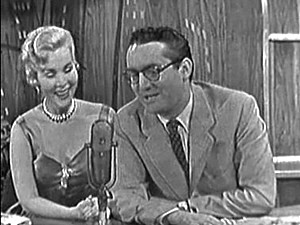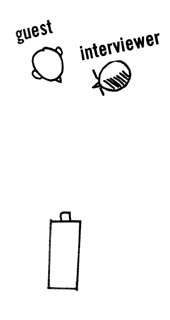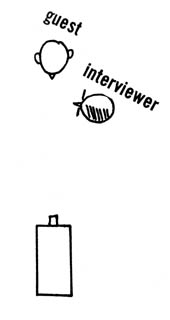Bammer
Interviews Brian
A
Lesson in TV Production
Written
September 8, 2002
Updated
April 27, 2009
A very common situation in sports television is the single-camera interview. One interviewer, one guest, one camera.
In preparing for the interviewer and guest to arrive, the TV crew sometimes will place two chairs side by side. However, we learned in the early days of television that this can be an awkward arrangement.
|
|
For example, here’s NBC's Tonight show three months after its debut, with side-by-side seating behind the desk. This arrangement resembles a radio show before a live audience. Both people are facing the camera, but if Steve Allen wants to actually look at his guest Zsa Zsa Gabor, he has to turn his head sharply to the right. |
|
It's usually better if the two people are at about a 90º angle to each other (as in this overhead view). The guest's left shoulder, ideally, should be almost touching the interviewer's right shoulder. Usually, the guest's answers are more important than the interviewer's questions. Yet the two people are often arranged symmetrically, with each person facing 45º away from the camera as shown here. That's not necessarily best. Why? Let's look. To demonstrate for us, we've prevailed upon a couple of characters: two free giveaways from the land of Pittsburgh Pirates baseball promotion. Here's how an interview is usually staged. |
|
|
|
|
|
|
|
|
Notice that when the two are conversing with each other, they're both almost in profile. The guest is not looking toward the camera at all; he's looking 90º away from it, at the interviewer. Such profile views can be less than flattering, especially when the camera zooms in to show only the guest's face.
|
Consider rotating the set 45º clockwise, as shown here. Now the guest faces directly toward the camera, while the interviewer stands off to one side. The closest part of the interviewer to the camera is his left shoulder. This might seem awkward, but if most of the interview is going to consist of a closeup of the guest, it gives better results. (However, this arrangement would not be an advantage if the interviewer plans to ask long questions, with as much on-camera time as the guest.) |
|
|
|
|
|
|
|
|
I
learned this principle long ago. As a matter of fact, the
overhead views are taken from an illustration in a textbook I used in
a class in 1969. A few years later, I remember watching Dave
Collins, a sports anchor for Channel 4 in Columbus, Ohio, conduct an
interview while standing with his shoulder facing the camera, and I
realized why.







